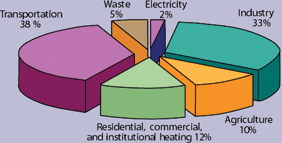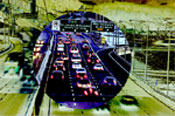
Natural Resources Canada > Earth Sciences Sector > Priorities > Climate Change Impacts and Adaptation > Climate Change in Canada
A change in the wind: Climate Change in Québec Emissions - How do we measure up ?
Activities that generate greenhouse gas emissions in Quebec
An analysis of greenhouse gas (GHG) emissions produced by various sectors of activity reveals that, in Quebec, the transportation of people and goods (38%) is the primary source of such emissions. The increased rate of household car ownership, urban sprawl, and the popularity of sport utility vehicles and trucking of goods are all factors that account for these figures.

Greenhouse gas emissions in Quebec in 1998
(Direction des changements climatiques, Environnement Québec) |
Industry ranks in second place (33%), contributing to the emission of GHGs through both the use of fossil fuels and the production and use of certain GHGs during processing.

Landfill site
(Environnement Québec) |
The contribution of residential, commercial, and institutional heating to emissions of GHGs (12%) is significantly lower than that of the two previous sectors, despite its third-place ranking.
Agriculture (10%) and landfill sites (5%) are the two least significant categories. The electricity category (2%) covers emissions generated by thermal power stations.
The amount of methane produced in Quebec by buried garbage (4.3 megatonnes of equivalent CO2 emission) corresponds to the exhaust emissions of almost one million passenger cars. As long as we continue to bury garbage, this problem will persist unless solutions are introduced.
Despite its northern geographic location, Quebec performs well because over 95% of the electricity it consumes is hydraulically generated. Electricity is used by 75% of housing units for heating, and by 95% for hot water.

Daniel-Johnson dam
(Environnement Québec) |

Motor traffic
(Environnement Québec) |
Did you know?
Methane is a very powerful greenhouse gas because it can retain 21 times more heat than CO2.
Did you know?
The average car emits over three times its weight in CO2 every year.
| 